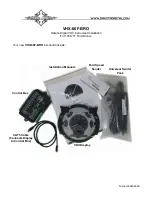
Oxygen Concentrator
28
Repair and Testing
Procedures
The following test and repair procedures have been developed to
allow for both performance verification of the CAIRE Companion 5 as
well as proper removal and replacement of defective parts. If a unit
fails any given test, refer to the Troubleshooting section of the manual.
Please carefully read and understand the following safety adviso-ries
before performing repair procedures.
WARNING:
CAUTION
Note:
•
All replacement parts must be factory ap-
proved. They should be marked “Cleaned
for Oxygen Service” and should be stored
in sealed plastic bags.
•
Use only replacement parts authorized by
CAIRE, Inc.
•
Service of the CAIRE Companion 5 should
be performed by authorized personnel only.
Do not allow liquid leak detector to come in
contact with electrical parts.
•
Verify that the power switch is in the “OFF”
position and the electrical cord is
unplugged before performing any repairs
unless otherwise noted.
•
Make sure your hands are free of oils and
greases.
Start-up Verification Test
1. Connect the electrical cord to a power supply.
2. Turn the power switch in the “ON” position.
3. Initially, all LED lights will illuminate and the audible alarm
will beep. After a few seconds, the yellow and red LED
lights should turn off and the audible alarm will stop.
4. Upon startup the O2 warning light will illuminate and the
display screen will read "O2 UP". Once the concentrator
reaches an acceptable purity the display screen will
change to the number of hours and the O2 warning light
will turn off.
5. Verify that the green LED turns on and stays lit
continuously during operation.
Power Failure Alarm Test
1.
Connect the electrical cord to a power source.
2.
Turn the power switch in the “ON” position and let the unit
run for a few minutes.
3.
Keeping the switch in the “ON” (I) position, disconnect the
electrical cord from its outlet power.
4.
Verify that the audible alarm begins to sound
.
Note:
If the audible alarm does not sound, refer to
the Troubleshooting section of the manual for
“No Power Failure Audible Alarm.”
5. Turn the power switch in the “OFF” (O) position. The
alarm should stop.
6. Plug the electrical cord back into an electrical outlet.
7. Turn the power switch in the “ON” (I) position. The green
light should remain lit continuously.
Flow Rate Test
1. Turn the power switch in the “ON” position.
2. Allow the concentrator to run continuously for a minimum
of 10 minutes.
3. Connect a flow meter to the outlet barb.
4. Turn the flow knob to the position of 0.5 LPM.
5. Verify that the flow displayed by the flow meter is within
the tolerances shown in table below.
6. Flow Rate must be +/- 10% or 200ml/min, whichever is
greater. See table below.
Table 8: Flow Rate Tolerances
Flow Setting
(LPM)
Minimum Actual
Flow (LPM)
Maximum Actual
Flow (LPM)
0.5
0.30
0.70
1.0
0.80
1.20
1.5
1.30
1.70
2.0
1.80
2.20
2.5
2.25
2.75
3.0
2.70
3.30
3.5
3.15
3.85
4.0
3.60
4.40
4.5
4.05
4.95
5.0
4.50
5.50
7. Repeat steps 4 and 5 with each incremental flow setting.
Note:
If any flow rates are out of tolerance, refer to
the Troubleshooting section of this manual and
the steps for Low or Fluctuating Flow Rates.











































